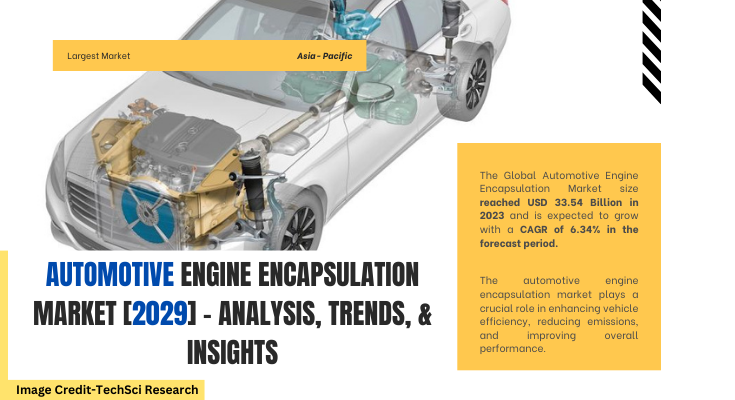According to TechSci Research report, “Automotive Engine Encapsulation Market – Global Industry Size, Share, Trends, Competition Forecast & Opportunities, 2029”, the Global Automotive Engine Encapsulation Market stood at USD 33.54 Billion in 2023 and is anticipated to grow with a CAGR of 6.34% in the forecast period, 2025-2029. The automotive engine encapsulation market is a significant segment of the automotive industry, focusing on improving the thermal management and efficiency of vehicle engines. Engine encapsulation involves the installation of protective panels or shields around the engine compartment to contain heat and reduce thermal losses. By enclosing the engine compartment, encapsulation helps to maintain optimal operating temperatures for the engine and surrounding components, improving fuel efficiency, reducing emissions, and enhancing overall vehicle performance.
One of the primary functions of automotive engine encapsulation is to improve thermal efficiency by reducing heat loss from the engine compartment. The heat generated by the engine during operation can escape through various openings and gaps in the engine compartment, leading to energy wastage and decreased fuel efficiency. Engine encapsulation helps to minimize heat dissipation by providing a barrier that traps heat within the engine compartment, allowing the engine to operate at higher temperatures more efficiently.
Moreover, automotive engine encapsulation contributes to reducing emissions and improving environmental sustainability by promoting more efficient combustion processes. By maintaining optimal operating temperatures, encapsulation helps engines reach their operating temperatures faster, reducing cold start emissions and improving catalytic converter efficiency. This results in lower levels of harmful emissions such as nitrogen oxides (NOx), hydrocarbons (HC), and carbon monoxide (CO), contributing to cleaner air and reduced environmental impact.
Additionally, engine encapsulation plays a crucial role in enhancing vehicle comfort and noise insulation by reducing engine noise and vibration transmitted to the vehicle’s interior. The protective panels or shields used in encapsulation act as sound insulation barriers, dampening engine noise and vibrations generated during vehicle operation. This leads to a quieter and more comfortable driving experience for vehicle occupants, particularly in urban environments or during highway cruising.
Furthermore, advancements in materials and engineering techniques are driving innovation in automotive engine encapsulation, leading to the development of lightweight, durable, and aerodynamic encapsulation solutions. Manufacturers are utilizing materials such as thermoplastics, composites, and acoustic insulating materials to design encapsulation panels that are lightweight yet effective in containing heat and reducing noise. Additionally, aerodynamically optimized encapsulation designs help to minimize drag and improve vehicle aerodynamics, further enhancing fuel efficiency and overall vehicle performance.
In conclusion, the automotive engine encapsulation market plays a vital role in improving thermal management, fuel efficiency, emissions reduction, and vehicle comfort in modern automobiles. By containing heat, reducing emissions, and minimizing engine noise, encapsulation contributes to enhancing overall vehicle performance, environmental sustainability, and driver comfort. Ongoing advancements in materials and design are expected to drive further innovation and adoption of engine encapsulation solutions across the automotive industry.
Browse over market data Figures spread through XX Pages and an in-depth TOC on “ Global Automotive Engine Encapsulation Market.” @ https://www.techsciresearch.com/report/automotive-engine-encapsulation-market/21228.html
The automotive engine encapsulation market is witnessing growth across various regions, including Asia Pacific, North America, Europe & CIS, South America, and the Middle East & Africa. Engine encapsulation involves the use of materials to enclose or cover the engine compartment, thereby improving vehicle aerodynamics, reducing noise, and enhancing fuel efficiency. Let’s explore the market overview of each region:
In the Asia Pacific region, which includes countries like China, India, Japan, and South Korea, the automotive engine encapsulation market is experiencing significant growth. Rapid urbanization, increasing disposable incomes, and a growing automotive industry are driving the demand for engine encapsulation solutions. Additionally, stringent emission regulations in countries like China and India are prompting automakers to adopt technologies that improve vehicle fuel efficiency, including engine encapsulation.
North America is another key market for automotive engine encapsulation, with the United States and Canada being major contributors to market growth. The region has a well-established automotive industry with a strong focus on vehicle performance and fuel efficiency. Stringent fuel economy standards and emission regulations in the region are driving automakers to invest in technologies like engine encapsulation to improve vehicle aerodynamics and reduce emissions.
Europe & CIS represent a mature market for automotive engine encapsulation, with countries like Germany, France, and Russia leading the market. The region has a strong automotive manufacturing base and is home to several leading automakers and suppliers of engine encapsulation materials. Stringent emission regulations in the European Union, coupled with consumer demand for fuel-efficient vehicles, are driving the adoption of engine encapsulation solutions in the region.
South America is witnessing steady growth in the automotive engine encapsulation market, with countries like Brazil, Argentina, and Chile driving market demand. The region’s automotive industry is growing, supported by rising consumer demand for fuel-efficient vehicles and government incentives for clean energy technologies. Engine encapsulation solutions are gaining popularity among automakers in South America as they seek to improve vehicle aerodynamics and fuel efficiency.
The Middle East & Africa region is also experiencing growth in the automotive engine encapsulation market, albeit at a slower pace compared to other regions. The region’s automotive industry is evolving, driven by infrastructure development, urbanization, and increasing consumer demand for vehicles with improved fuel efficiency. Engine encapsulation solutions are becoming increasingly important in the region as automakers focus on enhancing vehicle performance and meeting emission standards.
Overall, the global automotive engine encapsulation market is characterized by growth across multiple regions, driven by factors such as stringent emission regulations, consumer demand for fuel-efficient vehicles, and technological advancements in engine encapsulation materials. As automakers continue to prioritize vehicle performance and fuel efficiency, the demand for engine encapsulation solutions is expected to further drive market growth in the coming years.
Major companies operating in the Global Automotive Engine Encapsulation Market are:
- Röchling Group
- Adler Pelzer Holding GmbH
- Autoneum
- ElringKlinger AG
- Greiner Foam International GmbH
- Woco Industrietechnik GmbH
- Carcoustics
- Trocellen GmbH
- SA Automotive
- Continental Corporation
To Download FREE Sample Pages of this Report📥 @ https://www.techsciresearch.com/sample-report.aspx?cid=21228
Customers can also request 10% free customization in this report.
“In the rapidly advancing landscape of automotive technologies, industry foresees engine encapsulation as a pivotal solution, not only for meeting stringent emission standards but also for enhancing overall vehicle efficiency. The integration of innovative materials and smart technologies in encapsulation aligns with the industry’s pursuit of sustainability and heightened consumer expectations for a quieter and more comfortable driving experience. As the automotive sector evolves, anticipate engine encapsulation to remain a cornerstone technology, contributing to the ongoing transformation towards greener and more technologically sophisticated vehicles,” said Mr. Karan Chechi, Research Director with TechSci Research, a research-based management consulting firm.
“Automotive Engine Encapsulation Market – Global Industry Size, Share, Trends Opportunity, and Forecast, Segmented By Type (Engine Mounted and Body Mounted), By Material (Polyurethane, Carbon Fiber, Polyamide, Polypropylene and Others), By Vehicle Type (Passenger Cars and Commercial Vehicles), By Region, Competition, 2019-2029”, has evaluated the future growth potential of Global Automotive Engine Encapsulation Market and provides statistics & information on market size, structure, and future market growth. The report intends to provide cutting-edge market intelligence and help decision makers take sound investment decisions. Besides, the report also identifies and analyzes the emerging trends along with essential drivers, challenges, and opportunities in the Global Automotive Engine Encapsulation Market.
You may also read:
Wood Activated Carbon Market – Size, Share, Trends, In-Depth Insights 2028
Dioctyl Phenyl Phosphate (DOPP) Plasticizer Market Worth [2028], Overview, Trends, Forecast
Automotive Active Safety System Market – A Comprehensive Report [2029]
Table of Content-Automotive Engine Encapsulation Market
- Introduction
1.1. Product Overview
1.2. Key Highlights of the Report
1.3. Market Coverage
1.4. Market Segments Covered
1.5. Research Tenure Considered
- Research Methodology
2.1. Objective of the Study
2.2. Baseline Methodology
2.3. Key Industry Partners
2.4. Major Association and Secondary Sources
2.5. Forecasting Methodology
2.6. Data Triangulation & Validation
2.7. Assumptions and Limitations
- Executive Summary
3.1. Market Overview
3.2. Market Forecast
3.3. Key Regions
3.4. Key Segments
- Impact of COVID-19 on Global Automotive Engine Encapsulation Market
- Global Automotive Engine Encapsulation Market Outlook
5.1. Market Size & Forecast
5.1.1. By Value
5.2. Market Share & Forecast
5.2.1. By Type Market Share Analysis (Engine Mounted and Body Mounted)
5.2.2. By Material Market Share Analysis (Polyurethane, Carbon Fiber, Polyamide, Polypropylene and Others)
5.2.3. By Vehicle Type Market Share Analysis (Passenger Car and Commercial Vehicle)
5.2.4. By Region Market Share Analysis
5.2.4.1. Asia-Pacific Market Share Analysis
5.2.4.2. Europe & CIS Market Share Analysis
5.2.4.3. North America Market Share Analysis
5.2.4.4. South America Market Share Analysis
5.2.4.5. Middle East & Africa Market Share Analysis
5.2.5. By Company Market Share Analysis (Top 5 Companies, Others – By Value, 2023)
5.3. Global Automotive Engine Encapsulation Market Mapping & Opportunity Assessment
5.3.1. By Type Market Mapping & Opportunity Assessment
5.3.2. By Material Market Mapping & Opportunity Assessment
5.3.3. By Vehicle Type Market Mapping & Opportunity Assessment
5.3.4. By Regional Market Mapping & Opportunity Assessment
- Asia-Pacific Automotive Engine Encapsulation Market Outlook
6.1. Market Size & Forecast
6.1.1. By Value
6.2. Market Share & Forecast
6.2.1. By Type Market Share Analysis
6.2.2. By Material Market Share Analysis
6.2.3. By Vehicle Type Market Share Analysis
6.2.4. By Country Market Share Analysis
6.2.4.1. China Market Share Analysis
6.2.4.2. India Market Share Analysis
6.2.4.3. Japan Market Share Analysis
6.2.4.4. Indonesia Market Share Analysis
6.2.4.5. Thailand Market Share Analysis
6.2.4.6. South Korea Market Share Analysis
6.2.4.7. Australia Market Share Analysis
6.2.4.8. Rest of Asia-Pacific Market Share Analysis


